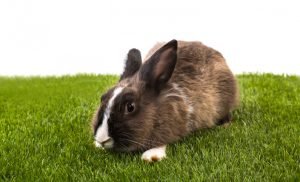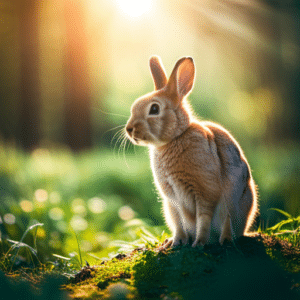What do rabbits eat in the wild? These adaptive creatures primarily consume a diet of grasses, leaves, bark, and flora, intricately tied to their environment and the changing seasons. Learn about the natural foraging habits of wild rabbits that keep them healthy and how human interactions can impact their diet.
Key Takeaways
- Wild rabbits primarily consume a diet of grasses, leafy plants, and flowers, with their diet varying seasonally; in winter, they may eat bark and twigs due to scarce food sources.
- Different species and habitats influence the diets of wild rabbits; for instance, urban rabbits may eat human-provided foods, while rural rabbits stick to natural vegetation.
- Feeding wild rabbits human food can disrupt their natural diet and lead to health issues while considering their natural diet is crucial when providing food for captive or orphaned wild rabbits.
Wild Rabbit Dietary Basics
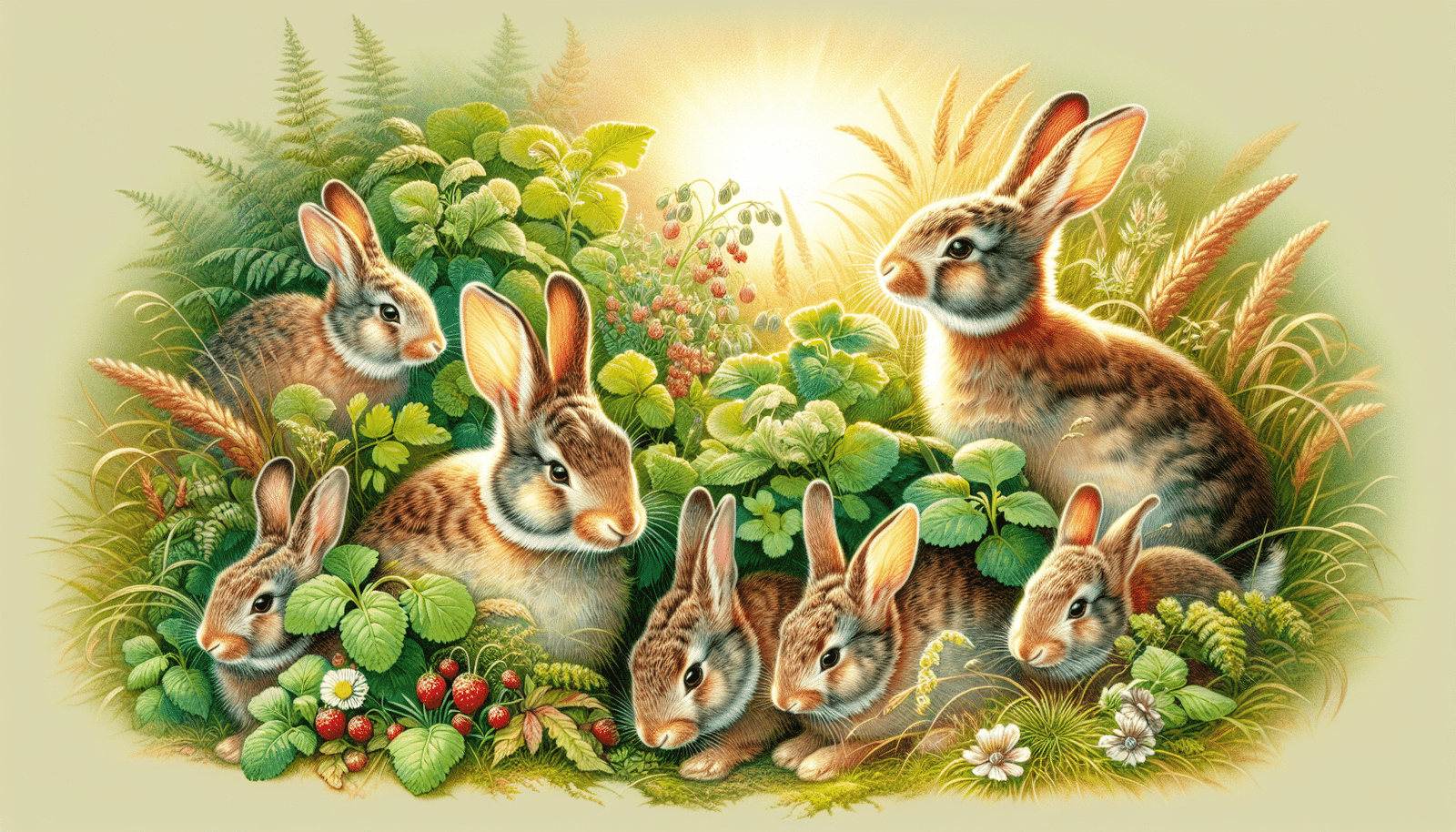
When you think about what rabbits eat, the image of a furry friend munching on a carrot might be the first thing that pops into your mind, thanks to popular culture. But, did you know that wild rabbits, unlike their domestic counterparts, rely primarily on grasses, leafy plants, and flowers? Picture a wild rabbit hopping through a meadow, feasting on a buffet of nature’s greens. This diverse diet is vital for their well-being, providing the essential vitamins and minerals they need.
As the wild rabbit hopscotch its way through the meadow, it actively consumes a diverse range of vegetation. Some of the foods that wild rabbits eat include:
- Clover
- Twigs
- Garden plants
- Tree bark
- Various greens
- Roots
So next time you see a wild rabbit in your garden nibbling on your plants, remember, that’s part of nature’s plan, contributing to the rabbit’s well-being.
But, are you aware that seasonal changes influence a wild rabbit’s diet? Or that human activities can interfere with their foraging routines? Let’s examine these aspects to gain more insight into the intriguing world of wild rabbits.
Seasonal Diet Changes
As the chilly winds of winter sweep in and the lush green vegetation fade away, wild rabbits face a scarcity of food sources. But just like the resilient creatures they are, they adapt their diet to survive. During these colder months, wild rabbits will often nibble on the bark and twigs of trees, making the best out of the situation. Imagine a rabbit bravely braving the cold, hopping through the snow-covered ground to find a tree, and nibbling on its bark – a testament to their survival instincts.
In rural areas, where the winter can be especially harsh, rabbits may rely heavily on the bark from trees. This highlights their adaptability in securing necessary nutrients like vitamins A and C even during tough times. Wild rabbits may also raid gardens to find fresh vegetables during the winter, further showcasing their ability to adapt to the scarcity of natural vegetation. So, if you notice some missing vegetables from your garden during winter, you might just have a wild rabbit visitor.
Their adaptability extends to their foraging behaviors, which are key to ensuring a balanced diet and not attracting predators. We’ll examine this in more detail.
Foraging Behaviors
Foraging is an essential behavior for wild rabbits, allowing them to find a diverse range of food sources. However, this behavior can be influenced by several factors. Ever heard of coprophagy? While it might sound strange to us, for cottontail rabbits, consuming some of their feces to reabsorb undigested nutrients is a behavior vital for their survival, particularly when their foraging is interrupted. It highlights the lengths these creatures go to maintain their health, especially when their natural food sources are disrupted.
Such disruption can occur when wild rabbits become accustomed to human-provided food sources. This can lead to a decrease in their foraging ability, changing their natural feeding behaviors. Imagine a wild rabbit that once hopped around exploring and foraging, now waiting for food to be provided. This alteration can lead to an inadequate variety of food sources, potentially leading to nutritional deficiencies impacting their immune health and fertility.
Grasping these dietary fundamentals of wild rabbits paves the way for investigating the feeding habits of various wild rabbit species. We’ll delve into this subsequently.
Types of Wild Rabbits and Their Diets
Massachusetts, a state rich in natural beauty, is home to two fascinating species of wild rabbits: the native New England Cottontail and the non-native Eastern Cottontail. These species, despite being different, coexist in human-populated areas, highlighting their incredible adaptability to different habitats. Imagine walking through a park in Massachusetts and spotting both the New England Cottontail and the Eastern Cottontail, coexisting in harmony. Such diversity within the same geographic region offers a unique opportunity to study their dietary habits and how they might vary.
However, how do the diets of urban and rural wild rabbits differ? And do Cottontail rabbits have different dietary habits compared to other species? We’ll probe further into these inquiries.
Urban vs. Rural Rabbits
When it comes to the diets of urban and rural rabbits, there are some fascinating differences. Urban rabbits, living in close proximity to humans, often include human-provided food in their diet. Leftover cereal and pet food, for instance, can find their way into the diet of these city-dwelling cottontails. Imagine a wild rabbit, right in the heart of the city, munching on some leftover cereal.
On the other hand, rural wild rabbits primarily consume a variety of natural vegetation. Plants like:
- clover
- dandelions
- grasses
- wildflowers
Wild rabbits are a species of wild animals commonly found in their diet. These adult wild rabbits forage for food in meadows and fields, far from human habitats, maintaining their natural dietary habits.
The presence and consumption of human-provided food by urban rabbits significantly impacts their natural dietary habits. This shows the dramatic influence human environments can have on the diets of wild rabbits. How about different species of wild rabbits? We’ll investigate this subsequently.
Cottontail Rabbits vs. Other Species
In Massachusetts, you’ll find that Eastern Cottontails are more common compared to New England Cottontails, which have become quite rare. This contrast in their numbers reflects differences in their habitat preferences and adaptability. Eastern Cottontails, being more adaptable, have a wider range, whereas New England Cottontails thrive in specific habitats, contributing to their rarity.
This diversity among rabbit species and their varying dietary habits underlines the importance of understanding their needs before providing them with food sources. Now that we’re on the topic of providing food, let’s examine how we can supply nutritious meals for wild rabbits.
Providing Nutritious Food Sources for Wild Rabbits
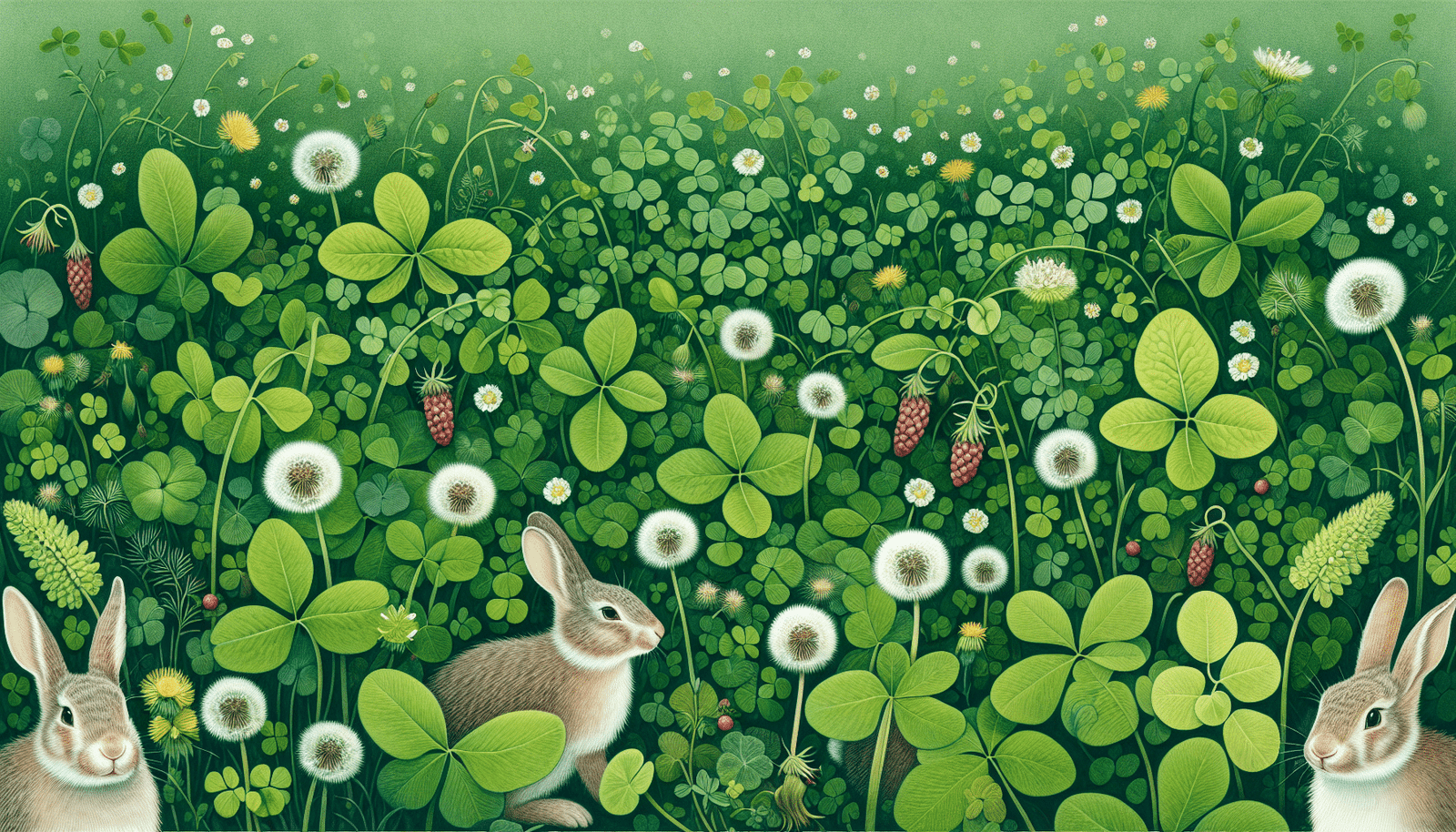
If you wish to support your wild rabbit visitors, providing them with the right food sources is crucial. Planting a variety of plants such as:
- clover
- dandelion greens
- kale
- oats
- ryegrass
in your gardens not only beautifies your space but also serves as a buffet for wild rabbits, providing them with nutritious greens. A diet lacking in variety can lead to nutritional deficiencies in wild rabbits, weakening their immune systems, and reducing fertility rates.
Wild rabbits, unlike pet rabbits, can also be fed safe berries as a part of their rabbit food, including where wild rabbits live:
- Blueberries
- Raspberries
- Strawberries
- Blackberries
Imagine the delight of a wild rabbit finding a patch of juicy berries in your garden! But what’s the best way to plant rabbit-friendly vegetation? And what lawn care practices ensure a safe environment for wild rabbits? We’ll delve into these subjects.
Planting Rabbit-Friendly Vegetation
To support wild rabbits’ dietary needs, consider planting an array of vegetation like clover leaves or berries in your garden. This not only adds to the aesthetic of your garden but also provides essential vitamins and minerals required for wild rabbits’ health. To support wild rabbits during winter, it’s beneficial to plant shrubs and greenery that are hardy and provide food sources without undermining their foraging instincts.
Some plants, such as aster, baby’s breath, bellflowers, black-eyed Susan, and clematis, along with vegetables like lettuce, peas, and beets, are good choices for supporting a wild rabbit’s diet. Wild rabbits are also drawn to an assortment of vegetables and fruits, including apples, beans, blackberries, raspberries, blueberries, broccoli, currants, gooseberries, grapes, kiwi, peppers, spinach, strawberries, and Swiss chard. Greens that rabbits enjoy include clover, dandelion greens, kale, oats, and ryegrass, which can be planted to offer them delicious and nutritious fodder.
Lawn Care Practices
While planting rabbit-friendly vegetation is crucial, maintaining a safe environment for them is equally important. Pesticides are toxic to wild rabbits and should be avoided to maintain a safe environment for them. Imagine a wild rabbit, happily hopping around your pesticide-free garden, nibbling on the delicious plants without any harm.
Employing non-toxic rabbit repellents like dried sulfur, powdered red pepper, or human hair can help keep rabbits away without the use of harmful chemicals. These can be strategically placed around your garden, ensuring that your plants are protected while keeping the rabbits safe.
Nonetheless, it’s important to responsibly provide nutritious food, taking into account the impact of human food on wild rabbits. We’ll examine this in more detail.
The Impact of Human Food on Wild Rabbits
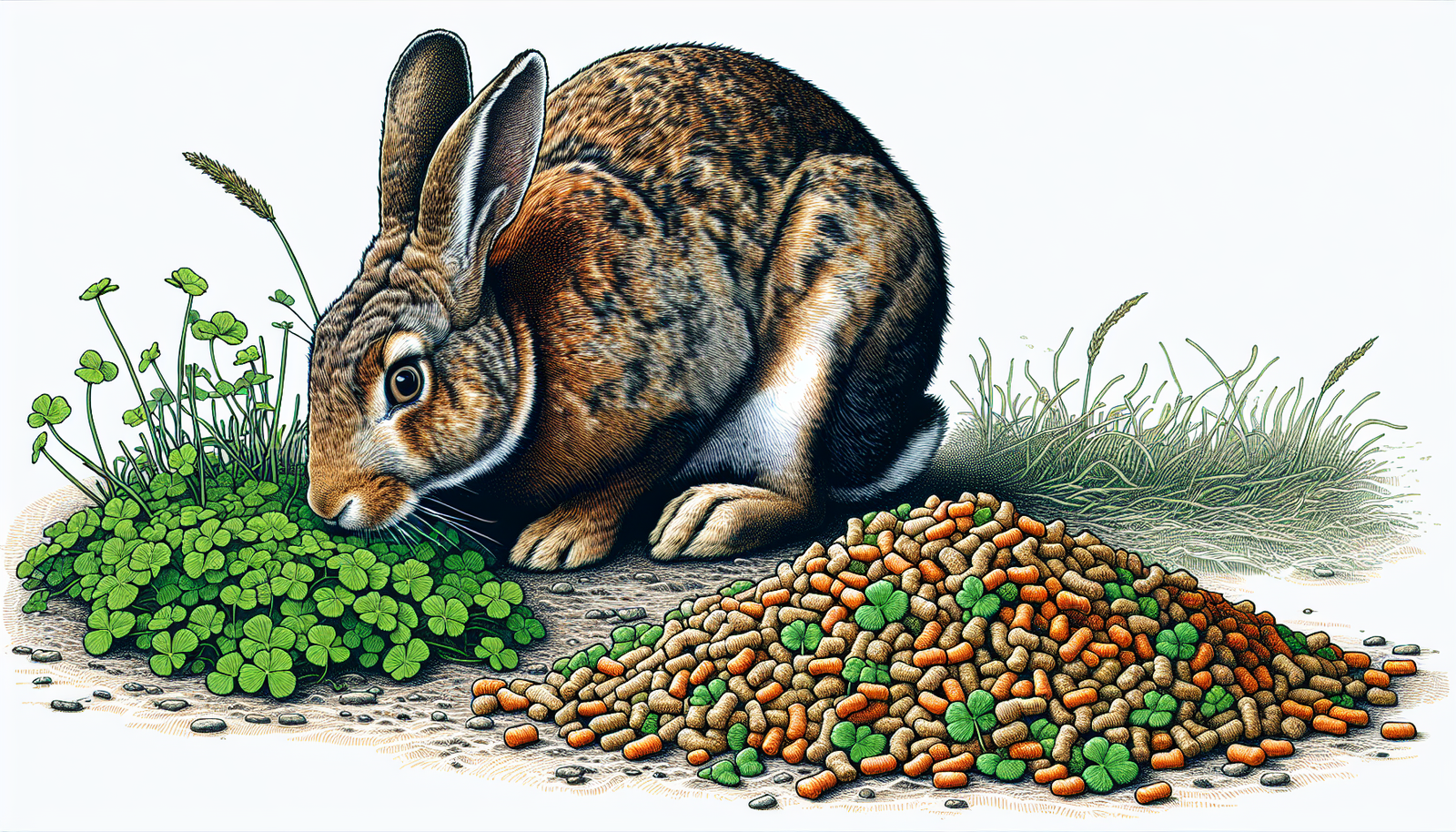
Feeding wild rabbits might seem like a kind gesture, but it can have unintended consequences. Feeding them human food like lettuce or carrots can disrupt their natural diet and may lead to digestive problems. Just like how fast food isn’t the best choice for us humans, human food isn’t the best choice for wild rabbits either!
Feeding them human food can also make them overly reliant on humans for sustenance. A wild rabbit that’s used to being fed may lose its natural instincts to forage for food, upsetting the balance of its diet and potentially putting its health at risk.
So, what food items should be avoided when feeding wild rabbits? And what risks are involved? Let’s probe further into these subjects.
Foods to Avoid
While the idea of feeding wild rabbits might be tempting, it’s essential to know what foods to avoid. Wild rabbits should never be fed:
- Potato vines
- Tomato vines
- Corn
- Beans
- Nuts
- Avocado
- Any plants related to onions, including garlic
Imagine a wild rabbit, a small wild animal, hopping away from these foods, instinctively knowing they are harmful.
Processed foods and high-sugar treats that do not provide nutritional value for wild rabbits include:
- Cereals
- Crackers
- Bread
- Granola bars
- Certain commercial rabbit snacks
Just like these foods aren’t the healthiest choices for us, they aren’t for rabbits either!
Inappropriate foods for wild rabbits include:
- Cooked foods
- Sweets
- Dairy products
- Foods like iceberg lettuce, bread, and crackers
These foods have poor nutritional content and can disrupt digestion in wild rabbits. Now that we know what to avoid, let’s look at the risks involved in feeding wild rabbits.
Attracting Predators and Other Risks
Feeding wild rabbits can lead to unintended consequences, such as attracting predators. Leaving food out in the yard for wild rabbits can attract other animals, including predators that can threaten the rabbits. Imagine a predator, lured into your yard by the food meant for the rabbits, threatening their safety.
Feeding wild rabbits can also lead to them becoming habituated to human food sources, which disrupts their natural foraging behavior. A wild rabbit that becomes used to human-provided food might lose its natural caution and foraging behavior, potentially putting its health and safety at risk.
Taking these risks into account, how about baby rabbits? Whether orphaned or in the wild, their dietary needs are unique. Let’s examine this further.
Baby Rabbits: Orphaned and In the Wild
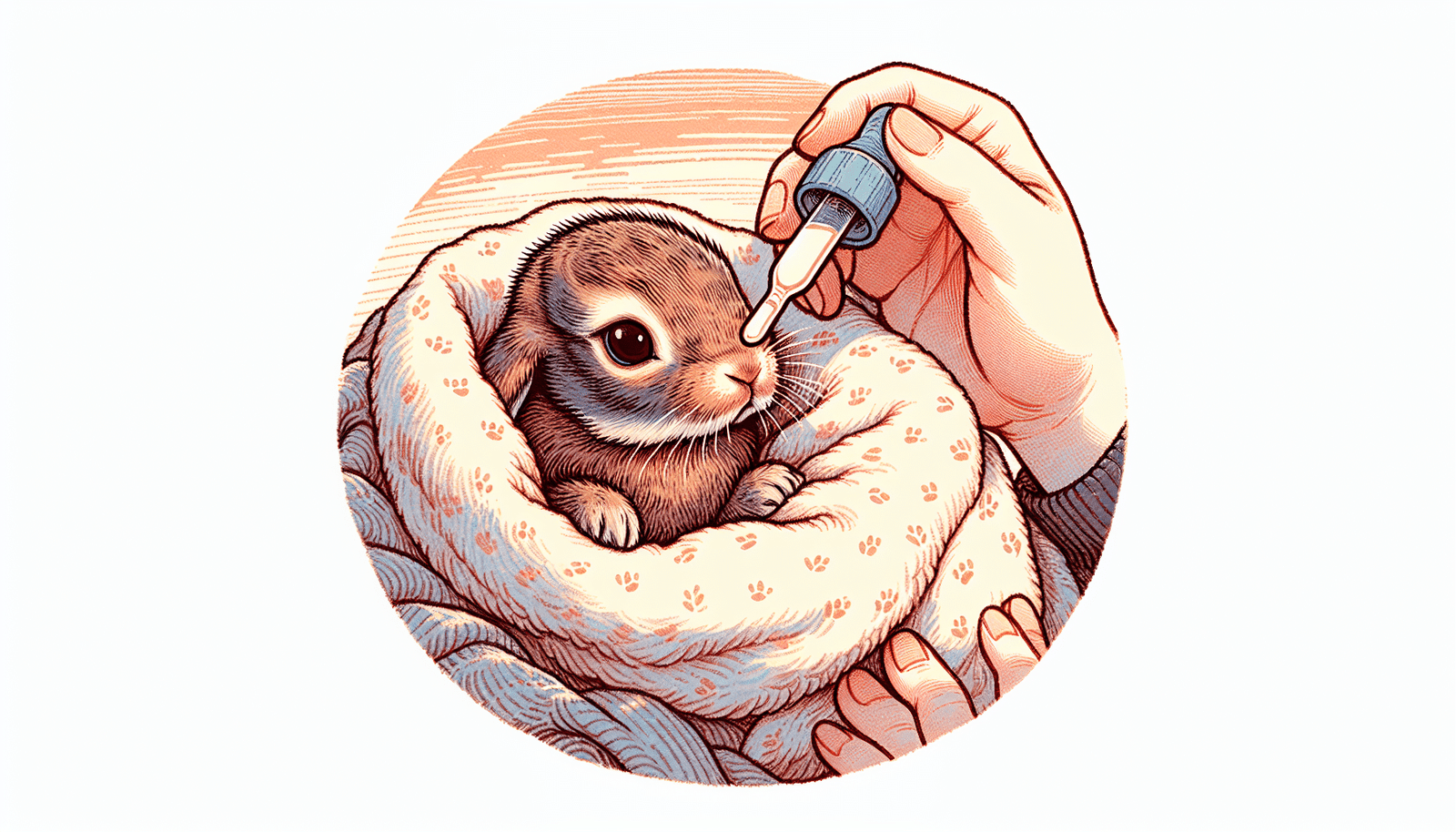
Baby rabbits, with their tiny size and adorable features, can quickly tug at our heartstrings. If you come across a nest of baby rabbits and don’t see the mother around, you might quickly assume they are orphaned. However, determining if a baby rabbit is orphaned requires careful observation; a mother rabbit may only return to the nest once a day. Imagine a mother rabbit, stealthily approaching the nest under the cover of darkness to feed her babies, and then disappearing again to avoid attracting predators.
If human intervention is necessary for suspected orphaned baby rabbits, it’s essential to provide warm, safe containment and seek expert advice promptly. Baby rabbits have unique dietary needs that are different from adults; they require one other’s milk or a specialized formula. Orphaned baby rabbits need to be fed with a syringe or dropper and require frequent feedings, usually every few hours. Contact with a wildlife rehabilitation center is crucial for orphaned wild baby rabbits to ensure proper care and eventual release back into the wild.
But how should orphaned baby rabbits be fed? And what do wild baby rabbits eat? Let’s delve into these subjects.
Feeding Orphaned Baby Rabbits
Feeding orphaned baby rabbits is a delicate task that should ideally be handled by a wildlife rehabilitation center. However, if immediate intervention is necessary, orphaned baby rabbits should be provided with a specific rabbit milk replacer or, in the absence of it, a homemade mixture, and should gradually transition to solid food by 28 days.
For hand-rearing, the milk or substitute mixture should be warmed to 37°C and fed using syringes or eyedroppers, with baby rabbits kept upright to prevent aspiration. Proper health management includes assisting with urination and defecation, monitoring milk consumption and weight daily, and providing access to fresh water as they grow.
Now that we know how to feed orphaned baby rabbits, what about wild baby rabbits? Let’s explore this next.
Wild Baby Rabbit Diet
Wild baby rabbits, just like their domestic counterparts, begin consuming their mother’s milk immediately after birth, which is vital for their growth and health. In the wild, baby rabbits are fed by their mothers approximately 1-2 times a day, with feedings capable of being up to 20% of the baby rabbit’s body weight. Imagine a mother rabbit, carefully feeding her babies, ensuring they receive the nutrition they need to grow.
Around 2 weeks old, wild baby rabbits start eating small amounts of hay and vegetables while still nursing from their mother. This gradual introduction of solid food helps them transition from milk to a diet of solids. Weaning off mother’s milk for wild baby rabbits occurs around 6 to 8 weeks of age as they transition completely to a diet of solids.
We’ve discussed the feeding of wild and baby rabbits, but what about feeding wild rabbits in captivity? We’ll examine this topic subsequently.
Feeding Wild Rabbits in Captivity
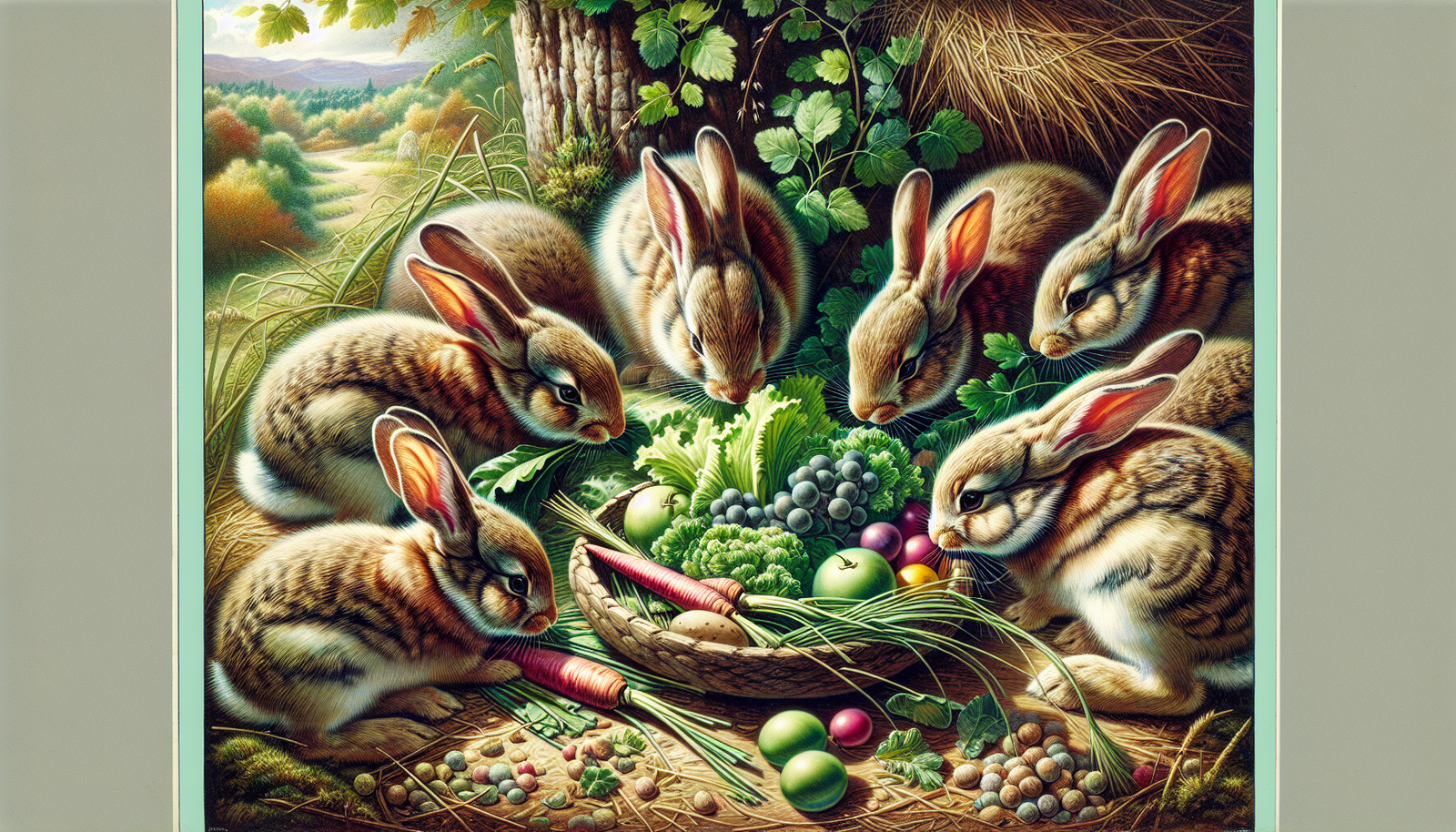
When providing food for captive wild rabbits, it is crucial to simulate their natural diet as closely as possible to support their recovery and maintain their health. A wild rabbit in captivity should be fed a diet that includes:
- A variety of greens
- Grass cuttings
- Clover
- Possibly timothy hay and dried grass if fresh greens are not available
Feeding amounts for captive wild rabbits should vary by weight and age, with feeding frequency adjusted accordingly to avoid the risk of bloat, which can be fatal.
What specific dietary guidelines should we adhere to for captive wild rabbits? And how crucial is fresh water for them? Let’s probe further into these subjects.
Diet Recommendations
Young captive wild rabbits benefit from alfalfa hay due to its high protein and calcium content, which supports growth. Imagine a young rabbit in captivity, happily munching on alfalfa hay, growing stronger day by day.
For adult captive wild rabbits, transitioning to hay with less calcium and protein, such as Timothy hay, is essential to prevent health issues as they mature. Ensuring TTimothy’shay is dry and free from mold is critical for the health of captive wild rabbits. A diet for captive wild rabbits should also include a variety of leafy greens and vegetables, such as Swiss chard, parsley, spinach, and carrots.
Now that we know what to feed captive wild rabbits, let’s not forget about the importance of fresh water for them, whether they are from a pet store or rescued from the wild.
Importance of Fresh Water
Water is vital for the survival of all living beings, and wild rabbits are no exception. They need plenty of water to stay hydrated, particularly during hot summer days. Imagine a wild rabbit in captivity, happily sipping on fresh water, staying hydrated and healthy.
It’s essential to provide captive wild rabbits with continuous access to clean and fresh water to maintain their health. In dry climates, providing bowls of fresh water for wild rabbits is necessary, with daily refreshments to prevent the growth of bacteria and mosquito nesting.
Now, let’s recap the main points from our investigation into the dietary habits of wild rabbits.
Summary
Understanding the dietary habits of wild rabbits is a fascinating journey, taking us from the meadows to urban gardens, and from the challenges of winter to the relative abundance of summer. Whether it’s the adaptable Eastern Cottontail the rarer New England Cottontail, the resilient urban rabbit, or the foraging rural rabbit, each species and habitat offers unique insights into their diet. Providing nutritious food sources, while avoiding harmful human food, is crucial for their survival. The specific dietary needs of baby rabbits, both orphaned and in the wild, and of those in captivity, further highlight the importance of a balanced diet for these creatures. Let’s use this knowledge to coexist harmoniously with these adorable creatures, respecting their diet and supporting their survival.
Frequently Asked Questions
What do wild rabbits eat?
Wild rabbits primarily eat grasses, leafy plants, and flowers, with their diet varying by season and habitat.
Can I feed my leftover food to wild rabbits?
No, it’s best to avoid feeding wild rabbits human food as it can disrupt their natural diet and may lead to digestive problems.
How can I support wild rabbits during winter?
You can support wild rabbits during winter by planting hardy shrubs and greenery that provide food sources, as winter can make food less abundant for them.
What should I feed an orphaned baby rabbit?
You should feed an orphaned baby rabbit a specific rabbit milk replacer or a homemade mixture, and gradually transition to solid food by 28 days.
How should I feed a wild rabbit in captivity?
You should feed a wild rabbit in captivity a diet of greens, grass cuttings, clover, and possibly timothy hay and dried grass if fresh greens are not available. This will ensure they receive the necessary nutrients and fiber.

